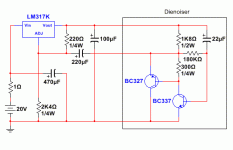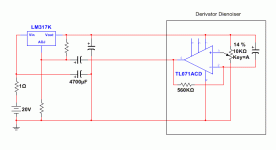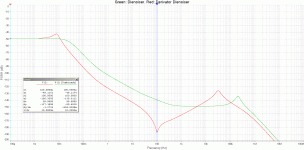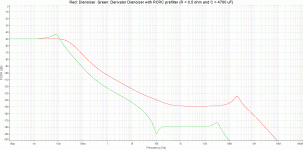This measurement shows the noise profile of the denoizer against a state of the art linear regulator, the LT3042.
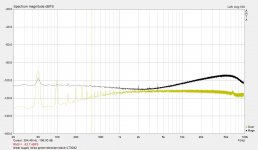
I decided that measurements against a bare LM317 were useless, so I mounted an LT3042 next to the 1000x head amp and made it switcheable.
The 50Hz and its harmonics are because of insufficient shielding of the denoizer. It is not because of lacking PSRR as the following measurements will show.

I decided that measurements against a bare LM317 were useless, so I mounted an LT3042 next to the 1000x head amp and made it switcheable.
The 50Hz and its harmonics are because of insufficient shielding of the denoizer. It is not because of lacking PSRR as the following measurements will show.
For the following measurement I constructed a dirty power supply out of a LM3886. I can superimpose an arbitrary signal on top of a DC voltage. For this measurement, a 1 V RMS ripple (2.8V peak to peak) was superimposed on a 18V DC voltage.
Since the AC output of the regulators gows through a 1000x amp, the top line (AC input) is actually 60dB higher than shown. PSRR at a given frequency is the difference between the AC input and the plot for the given regulator.
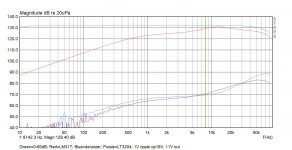
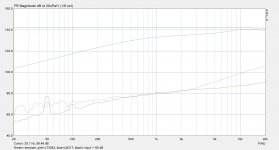
I show both measurements because there were fluctuations using different measuring systems.
It is fair to say, that the denoizer is at least at par with the LT3042 in audio frequencies. These measurements also show that the 50Hz bump is caused by pick up.
In order to improve these measurements, I will have to increase shielding and do manual sweeps at higher frequencies. There are also other indications that the denoizer performs less well at higher frequencies than the LT3042. The sims also show an increasing covergence between bare LM317 and denoizer above 100 kHz
Since the AC output of the regulators gows through a 1000x amp, the top line (AC input) is actually 60dB higher than shown. PSRR at a given frequency is the difference between the AC input and the plot for the given regulator.


I show both measurements because there were fluctuations using different measuring systems.
It is fair to say, that the denoizer is at least at par with the LT3042 in audio frequencies. These measurements also show that the 50Hz bump is caused by pick up.
In order to improve these measurements, I will have to increase shielding and do manual sweeps at higher frequencies. There are also other indications that the denoizer performs less well at higher frequencies than the LT3042. The sims also show an increasing covergence between bare LM317 and denoizer above 100 kHz
Finally, in order to see the possible effects of multiple tones, I put a multitone on top of the DC voltage. It clearly shows the superiority of the denoizer. The bumps after 50K are noise shaping artifacts of the converter. Even the artifacts of the denoizer stay well under the noise of the LT3042!
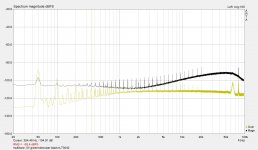

It is the one in #430
With Q6 disconnected from C10?
The Denoiser is not working then.
It is the one in #430
Try this very simplified second version of the Dienoiser (only for dirty test). The 47 ohm resistor has been suppressed, allowing the PSRR to be increased by approx. 1.26 dB within much of the audible band (as long as the regulator output is never short-circuited). An RC filter has been added to the regulator input, significantly improving the PSRR at high frequency. I have considered that the 22 nF capacitor may not be strictly necessary, although it should be tested in the workbench.
Slightly altering the value of the 300 ohm resistor could improve the PSRR curve. Possibly, between 330 and 390 ohms changes can be noticed, although it should be tested in the workbench.
The two protection diodes around the LM317K have not been drawn, for mayor clarity.
The 1 ohm resistor should be around 10 W @ 1,5 A max. output current.
Attachments
Last edited:
Thanks for the tests.
This is somewhat surprising, because the Dienoiser should be similar to the nonoiser, ie. 10~20dB better than the denoizer.
The 1kHz PSRR of the nonoiser is at least 125dB, about 15dB better than the denoizer.
The denoizer is about 30dB better than a cap-fitted 317, which fits with your measurements
Thus, your measurements apply to the Dienoiser, not the regular (1-transistor) denoizer?It is the one in #430
This is somewhat surprising, because the Dienoiser should be similar to the nonoiser, ie. 10~20dB better than the denoizer.
The 1kHz PSRR of the nonoiser is at least 125dB, about 15dB better than the denoizer.
The denoizer is about 30dB better than a cap-fitted 317, which fits with your measurements
Thanks for the tests.
Thus, your measurements apply to the Dienoiser, not the regular (1-transistor) denoizer?
This is somewhat surprising, because the Dienoiser should be similar to the nonoiser, ie. 10~20dB better than the denoizer.
The 1kHz PSRR of the nonoiser is at least 125dB, about 15dB better than the denoizer.
The denoizer is about 30dB better than a cap-fitted 317, which fits with your measurements
That is why, Elvee, which I suggested to vacuphile to short-circuit the 300 resistor between base and emitter of the PNP transistor, as to carry a double test in one (both the Denoiser and the Dienoiser)
Elvee, Diego,
I think my measurements show a difference in PSRR of almost 60 dB between a LM317 with cap and the Dienoizer. At 1kHz, the PSSR of the Dienoiser is 190-65=125dB.
I have a question for Elvee. I work with BC549/560, a low noise high Hfe combo I know well. However, you suggested that there would be better transistors out there. What could be improved?
As soon as I have time, I will see what the difference is of shortening the 300 Ohm resistor. The value of which, as measurements of some values have shown, is not all that critical after all. Once I can start testing I will see if I can make a little overview.
BTW, I need to do these measurements again anyways. The reason is that my 1000x was not really flat but more like a high pass filter.
To be continued.
I think my measurements show a difference in PSRR of almost 60 dB between a LM317 with cap and the Dienoizer. At 1kHz, the PSSR of the Dienoiser is 190-65=125dB.
I have a question for Elvee. I work with BC549/560, a low noise high Hfe combo I know well. However, you suggested that there would be better transistors out there. What could be improved?
As soon as I have time, I will see what the difference is of shortening the 300 Ohm resistor. The value of which, as measurements of some values have shown, is not all that critical after all. Once I can start testing I will see if I can make a little overview.
BTW, I need to do these measurements again anyways. The reason is that my 1000x was not really flat but more like a high pass filter.
To be continued.
OK, that matches my measurement on the nonoiser, which is very comparable to the DienoiserElvee, Diego,
I think my measurements show a difference in PSRR of almost 60 dB between a LM317 with cap and the Dienoizer. At 1kHz, the PSSR of the Dienoiser is 190-65=125dB.
Practically any medium-power transistor would do better. A cheap and easy upgrade is the BC337, but many are even better: the ZTX851, of course because of its record Rbb value, but many low-noise alternatives exist like 2SC6043 or the good old 2N5401.I have a question for Elvee. I work with BC549/560, a low noise high Hfe combo I know well. However, you suggested that there would be better transistors out there. What could be improved?
Even a cheap Chinese S8050 is significantly better than a BC337.
Note that if you use a very high performance device like the ZTX, the 47 ohm protection resistor will become the main noise source, and should be reduced to 22 or 10 ohm
Thank you for suggesting this transistor.
I have improved my 1000x amp but now the lack of shielding is making measurements at the required level impossible. To make adequate shielding will require a bit more time than I have before I leave for the Far East Tuesday next week. Will be gone for 2 months, so in the meanwhile, I really enjoyed learning and doing all this. Thanks to everybody.
I have improved my 1000x amp but now the lack of shielding is making measurements at the required level impossible. To make adequate shielding will require a bit more time than I have before I leave for the Far East Tuesday next week. Will be gone for 2 months, so in the meanwhile, I really enjoyed learning and doing all this. Thanks to everybody.
Which should be the best capacitors, brand and model, for input filter and other types?
The only one I know shouldn't be a low ESR type is the output capacitor, but the others I'm not sure.
A standard used by many are Panasonic FC, but models from Nichicon and Chemi-con might be good too. So which are better?
The only one I know shouldn't be a low ESR type is the output capacitor, but the others I'm not sure.
A standard used by many are Panasonic FC, but models from Nichicon and Chemi-con might be good too. So which are better?
So which are better?
"Better' for what? Measurements, Sound, Cost, Size, etc?
Precisely. I am also curious about what is being achieved. LM317 is nothing more than an op-amp. Feeding back some wideband stuff into the inverting input does what exactly.
Precisely. I am also curious about what is being achieved. LM317 is nothing more than an op-amp. Feeding back some wideband stuff into the inverting input does what exactly.
What about lowering PSRR, impedance and noise? It does exactly that.
Nico,
Please have a look at the measurements I made. There is easily a 50 dB improvement over an LM 317 with bypassing cap over the set resistor.
If you really want to find out what is happening, you need to take an in depth look at the schematic of the 317, which you will find at TI.
Please have a look at the measurements I made. There is easily a 50 dB improvement over an LM 317 with bypassing cap over the set resistor.
If you really want to find out what is happening, you need to take an in depth look at the schematic of the 317, which you will find at TI.
Just be sensible: use any half-decent cap, even a generic type like Multicomp.Which should be the best capacitors, brand and model, for input filter and other types?
The only one I know shouldn't be a low ESR type is the output capacitor, but the others I'm not sure.
Avoid "boutique" or "audio" types like the plague, do not use a solid polymer at the output, but other than that opt for any normal cap.
The input cap can be a very low esr type like solid polymer, the output cap can have a reasonably low esr (not ultra-low), and the two coupling caps are completely indifferent: anything will do.
The capacitors choice is not critical, and will have no or little influence on the performances.
Very important: do not parallel the Ecaps with other types, like film or ceramic: that's asking for trouble as Rick noticed (this advice has a general value and can be applied to any other circuit)
Derivator Dienoiser
Derivator Dienoiser
What about this?
With RC prefilter. R = 1 ohm and C = 4700 uF:
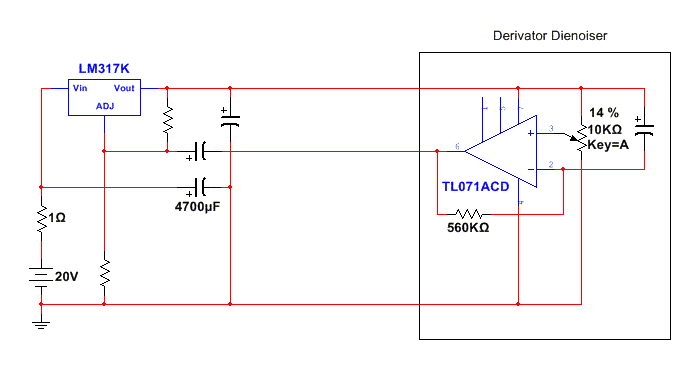

With RCRC prefilter. R = 0,5 ohm and C = 4700 uF:
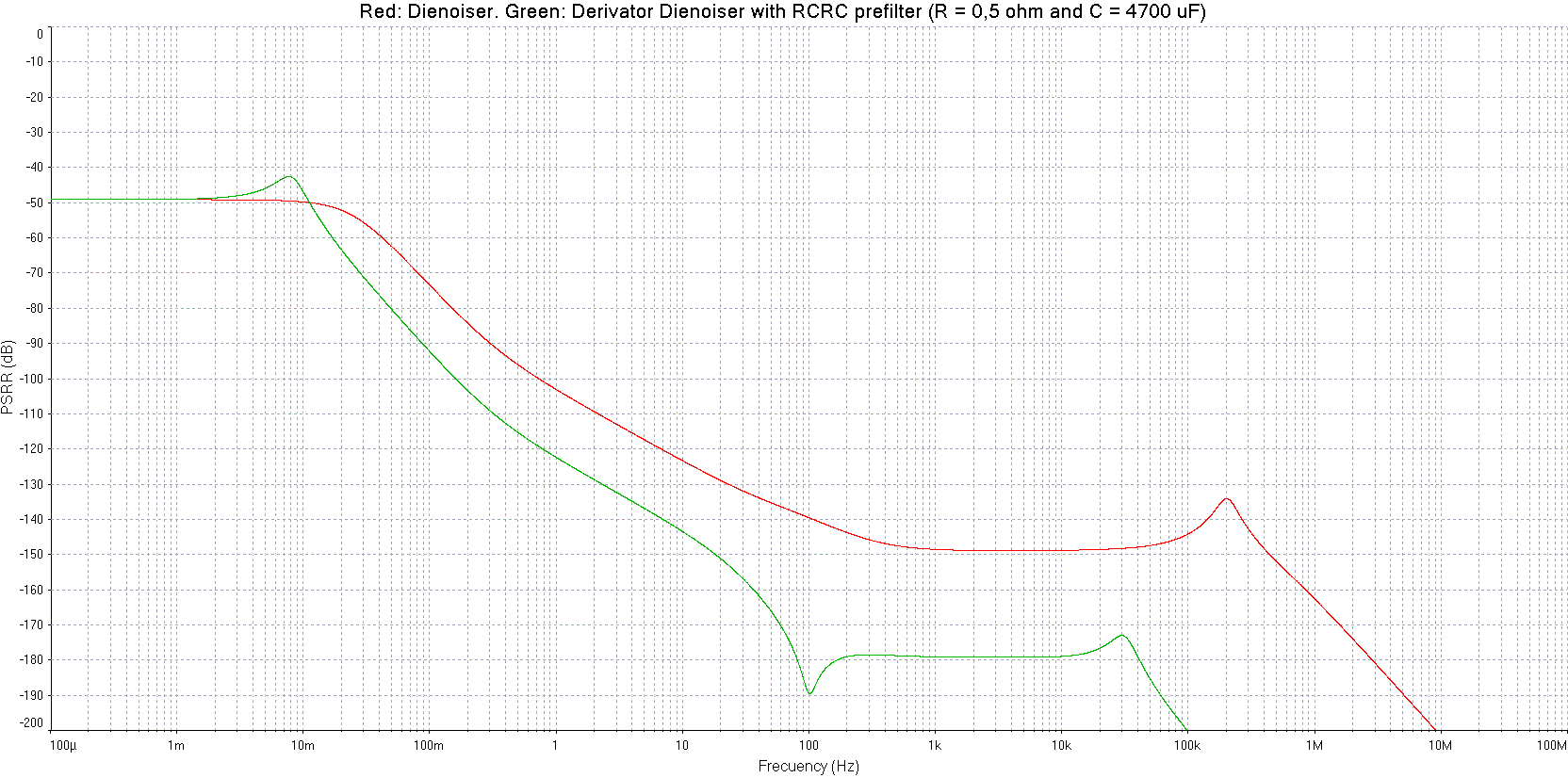
Derivator Dienoiser
What about this?
With RC prefilter. R = 1 ohm and C = 4700 uF:
With RCRC prefilter. R = 0,5 ohm and C = 4700 uF:
Attachments
Last edited:
- Home
- Amplifiers
- Power Supplies
- D-Noizator: a magic active noise canceller to retrofit & upgrade any 317-based V.Reg.
